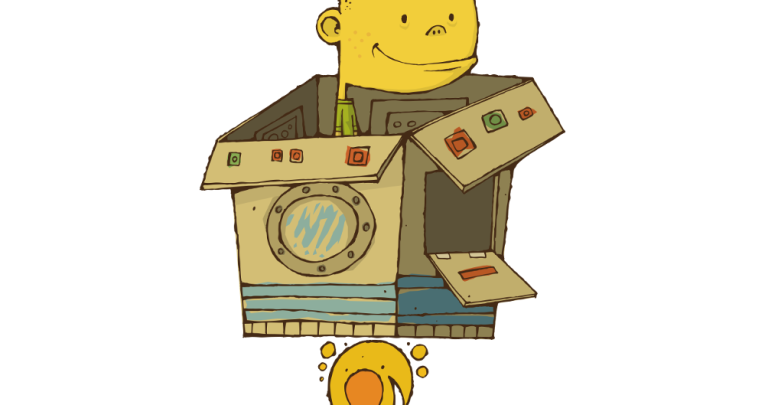Deconstructing role play – Provide the resources, step back and watch children’s learning flourish

The joy of this type of role play is that anything can be anything. There are no rules, no limits and no expectations…

- by Ben White
- Co-headteacher at Crawley Green Infant School

Hospital, vet’s surgery, post office, travel agent – themed role play areas are often seen as a must for an early years setting. They are often meticulously prepared to be aesthetically pleasing, covered in laminated words and pictures with the aim of enticing children in.
But this is where I encountered a problem: in these areas, children are expected to come together to play out adult scenarios that are consistent with these themes. Yet how many children have visited a travel agent to book a holiday recently, or operated on a pet dog in a vet’s surgery?
For the majority of children, themed areas such as those described above are simply too alien for high-quality cooperative play to develop – which is why I found the children in my class would revert back to playing ‘mums and dads’ by mid-morning, rather than booking a holiday to Costa Rica, as the poster on the wall in the travel agent suggested!
I decided action had to be taken; it was time to improve my role play corner. And so I deconstructed it!
What do you need?
Simply leave out a selection of cardboard boxes (the bigger, the better), crates, empty cable reels, string and sheets of fabric. Basically, think large-scale junk modelling and you can’t go wrong.
You will also need a fair amount of floor space for children to construct and then play with their creations afterwards.
Links to a current story or topic make good enhancements and don’t be afraid to add in some resources from the traditional role play area, too: plates, cups, dolls and food can always be made good use of.
Masking tape is a must when constructing and don’t forget markers and large sheets of paper for signs, labels and plans. Children will naturally source their own objects and materials from around the classroom, and this should be openly encouraged.
Finally, children will need uninterrupted time so that high-quality play can develop and be sustained over time.
The benefits
Once it is embedded within your classroom, the benefits of deconstructed role play will surprise you every day. For me, it is the only indoor area where I have seen true cooperative play at its highest level on a daily basis, and this is due to the limitless possibilities it offers.
Regardless of personal experience or lack of, everyone can contribute something. It develops leadership skills in children, encouraging them to take on real-life roles in real-life situations.
The sense of pride and achievement elicited by completing a construction raises self-esteem and confidence in all who contributed as they reap the benefits of working together.
Here are six more reasons to consider introducing it to your classroom:
- It’s truly child-initiated. The play that takes place in deconstructed role play is initiated and developed entirely by the children and as a result is more purposeful and more likely to be sustained over time.
- There are no limits. From Lamborghinis, to ice palaces to helicopters – anything you can imagine can be constructed.
- It promotes talk. Children will use language while constructing, while playing with the creation afterwards will encourage the use of narrative and storytelling skills.
- Boys love it. In my classroom, deconstructed role play has been particularly beneficial for the boys. They thrive with this style of play, and happily spend hours planning, constructing, reviewing and improving. They will then return to their construction the next day to continue the play, often extending it without any adult intervention required.
- Children naturally take on roles. Deconstructed role play generally involves ‘real-life’ roles – the boss, the builder, the planner, the resource supplier.
- Thinking critically. Children will work together to solve problems, reviewing their work and finding ways to improve their constructions.
Identifying cooperative play
As teachers observing high-quality play, we can spot that look of intense concentration on a child’s face as they meticulously complete the trickiest of tasks. Cooperative play is more difficult to identify. Firstly, you need a group of children to be playing alongside one another in that deep level of concentration.
Within the group, they will have their own roles, defined by their personality or hierarchy in the group, perhaps. The theme or intended outcome would have been set early on in the play and will be sustained throughout.
Children may leave the group freely, and be reaccepted when they return. Resources will be shared with one another and children will help each other out to complete difficult tasks, such as threading string through a cardboard tube or tying a knot to hang a piece of fabric.
Children will talk to each other when they need to, sometimes discussing new ideas or often just to chat about last night’s TV as they work collaboratively alongside one another.
Other times, children will construct in complete silence, as conversation is not needed when everyone has their own job to do.
The adult’s role in cooperative play is important. In actual fact, an adult in true cooperative play is not needed and seldom sought. I once suggested to a group of children that the helicopter they were creating might need a couple of blades on top.
But no, its two “turbo-powered fire blasters” at the back were more than enough to make it fly!
In my experience the adult’s role is to facilitate the play. Often they become the dogsbody, fetching resources from around the classroom when ordered by the ‘boss’ of the group, or used to talk through ideas and listen to the complexities of the design.
In cooperative play, the theme will continue for long periods of time and often into the next day, if allowed.
With deconstructed role play, after completing a construction, children will return and interact with it in a more imaginative style of play.
They will be proud of their creation and will want to spend time driving their Lamborghini down the motorway or flying their helicopter through thunderstorms and tornadoes.
The best of both worlds
Although in my classroom I have chosen to replace the ‘traditional’ role play corner for the time being, it is still important for children to have the opportunity to play in more familiar role play situations, such as the home.
In my setting, children have free-flow access to other classrooms and therefore can still access a home corner, should they choose – try to work with colleagues to develop role play opportunities that work for all children in your setting.
6 steps to success
- Add new resources regularly – different-sized boxes, costumes, planks… Anything that will capture the imagination.
- Keep finished masterpieces for children to return to. This may mean leaving constructions up overnight so that children can extend their role play the next day.
- Sneak in mark making opportunities. Backing a wall with paper allows children to create scenes and backdrops, too.
- Allow and encourage children to be resourceful and take things from around the classroom.
- Observe the play taking place and only interact when invited. Even then, continue to allow the children to lead the play and avoid the temptation to suggest new ideas yourself.
- Look out for and praise children who take on roles that are relevant in the real world. Use this as an opportunity to promote life skills and discuss aspirations.
Ben White is early years leader at Denbigh Primary School in Luton. Follow him on Twitter at @benwhitej.










